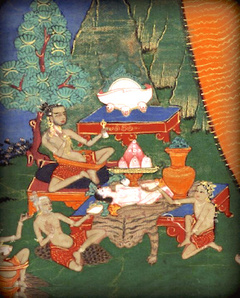Tsok Series
Practices › Tsok
English (34) | Deutsch (3) | Español (3) | Français (6) | 中文 (6) | བོད་ཡིག (33)

Detail from a thangka showing a tsok offering
Courtesy of Himalayan Art Resources
Lotsawa House presents the following texts related to the practice of tsok (tshogs) or feast-gathering (Skt. gaṇacakra):
Introduction
Explanation
- Music to Adorn the Illusory Display: A Concise Explanation of the Nature of the Feast Offering by Jamgön Kongtrul Lodrö Thaye
Offering Liturgies
- Cloud-Banks of the Two Accumulations: A Feast Offering Including the Six Vajra Lines Prayer to Be Practiced with Any Guru Sādhana by Chokling Tersé Tulku
- A Splendid Profusion of Merit: A Feast-Offering for the Secret Practice of the Great Compassionate One, Natural Liberation of Suffering from The Heart-Essence of the Vast Expanse by Dodrupchen Jigme Trinle Özer
- The Lotus Garland: A Short Feast-Offering for the Female Practice of the Heart-Essence of the Vast Expanse by Fourth Dodrupchen Rinpoche
- Bestowing the Glory of Wisdom: A Gaṇacakra Feast for Nyingtik Saldrön by Jamyang Khyentse Chökyi Lodrö
- A Glorious Garland of the Two Accomplishments: An Abridged Feast-Offering for the Female Practice of the Ḍākinī by Jamyang Khyentse Wangpo
Prayers
- The Brief Tsok Feast Offering Prayer from 'The Profound Path of the Ḍākinīs' Heart Drop' by Dudjom Rinpoche
- Verses for Accumulating the Tsok Offering of the Combined Practice of the Three Roots (Tsasum Drildrup) by Jamyang Khyentse Chökyi Lodrö
- Verses for Accumulating the Tsok Offering of the Great Compassionate One by Jamyang Khyentse Chökyi Lodrö
- Confession and Fulfilment Insert for Accumulating the Practice of Turning Back the Summons of the Ḍākinīs by Jigme Lingpa
A brief gaṇacakra liturgy to be recited when accumulating tsok offering on a large scale.
- Excellent Vase of Splendour: The Tsok Feast Offering to Accompany the Vajra Seven-Line Prayer by Mipham Rinpoche
An extremely concise liturgy to accompany a gaṇacakra feast offering of sensory delights.
Remainder Offering
Songs
Composed in 1940 during a tsok practice of Tukdrup Barche Kunsel together with the King of Ling.
- Harmonious Clouds of Sublime and Lasting Bliss: A Vajra Song for the Tsok Feast Offering to Venerable and Exalted Vajrayoginī by Jamyang Khyentse Wangpo